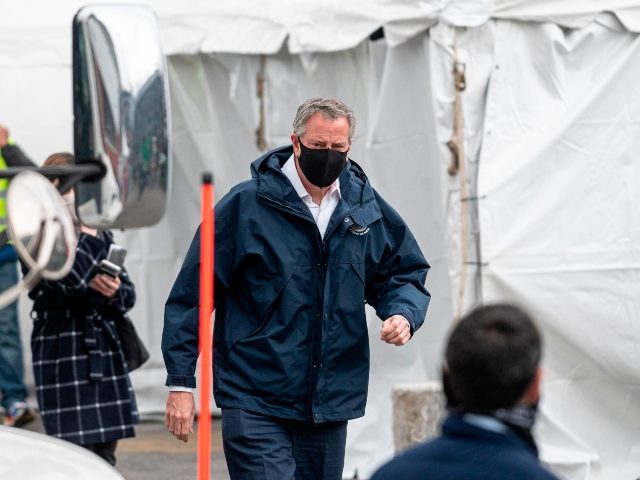New York City Mayor Bill de Blasio pushed for a “crucial” emergency coronavirus hospital that remained open for 33 days before closing.
An exposé published by the New York Times reveals “missteps made at every level of government” in the production of a specialized coronavirus overflow hospital set up at the Billie Jean King National Tennis Center in Queens. The facility treated just 79 patients over the course of 33 days before shutting down.
Mayor de Blasio claimed “This facility will be crucial” in March, but by May 13 its disused wards were shuttered. One of the mayor’s aides, Jackie Bray, told the Times “the alternative space was less used than we expected it to be because we broke the curve, thank goodness.” But that does not appear to be the whole story, if NYT investigative reporter Brian M. Rosenthal’s findings are to be believed:
The Queens Hospital Center emergency department has a capacity of 60, but on its worst night of the coronavirus pandemic, more than 180 patients lay on stretchers in the observation bays and hallways. Alarms rang incessantly as exhausted doctors rushed from crisis to crisis.
Less than four miles away, a temporary hospital opened the next morning, on April 10. The facility, which was built at the U.S.T.A. Billie Jean King National Tennis Center to relieve the city’s overwhelmed hospitals, had hundreds of beds and scores of medical professionals trained to treat virus patients.
But in the entire month that the site remained open, it treated just three patients from the Queens Hospital Center emergency department, records show. Over all, the field hospital cost more than $52 million and served only 79 patients.
The city reportedly paid some doctors as much as $732 per hour at a location that refused patients with fevers. In fact, there were as many as “25 medical conditions that disqualified patients from being transferred to Billie Jean King.” But beyond the stringent health requirements, healthcare workers on the ground floor of the NYC pandemic response suspected another reason for the facility’s disuse.
“Several doctors at public hospitals said they believed their bosses did not want to transfer because the hospitals in the public system each had their own budgets, and they did not receive revenue from patients they sent away,” Rosenthal wrote. “Some said they were told Billie Jean King could treat only people with extremely mild symptoms.”
And despite its alleged purpose to treat the “critically ill,” the facility opened with just two ventilators. “I basically got paid $2,000 a day to sit on my phone and look at Facebook,” a nurse practitioner who worked at the Billie Jean King location told the NYT. “We all felt guilty. I felt really ashamed, to be honest.”
Medical personnel working in over-crowded city facilities echoed their disappointment. “Knowing what our patients had to endure in an overcrowded emergency department, it’s frustrating how few patients were treated at facilities such as Billie Jean King,” Dr. Timothy Tan, director of clinical operations at the Queens Hospital Center emergency department, said.
“We were sitting on all of these beds with hundreds of people trained to watch over patients exactly like that, and these people died,” said Elizabeth Ianelli, a social worker at the site, speaking of three men who died under quarantine in a hotel nearby. “That was preventable.”

COMMENTS
Please let us know if you're having issues with commenting.